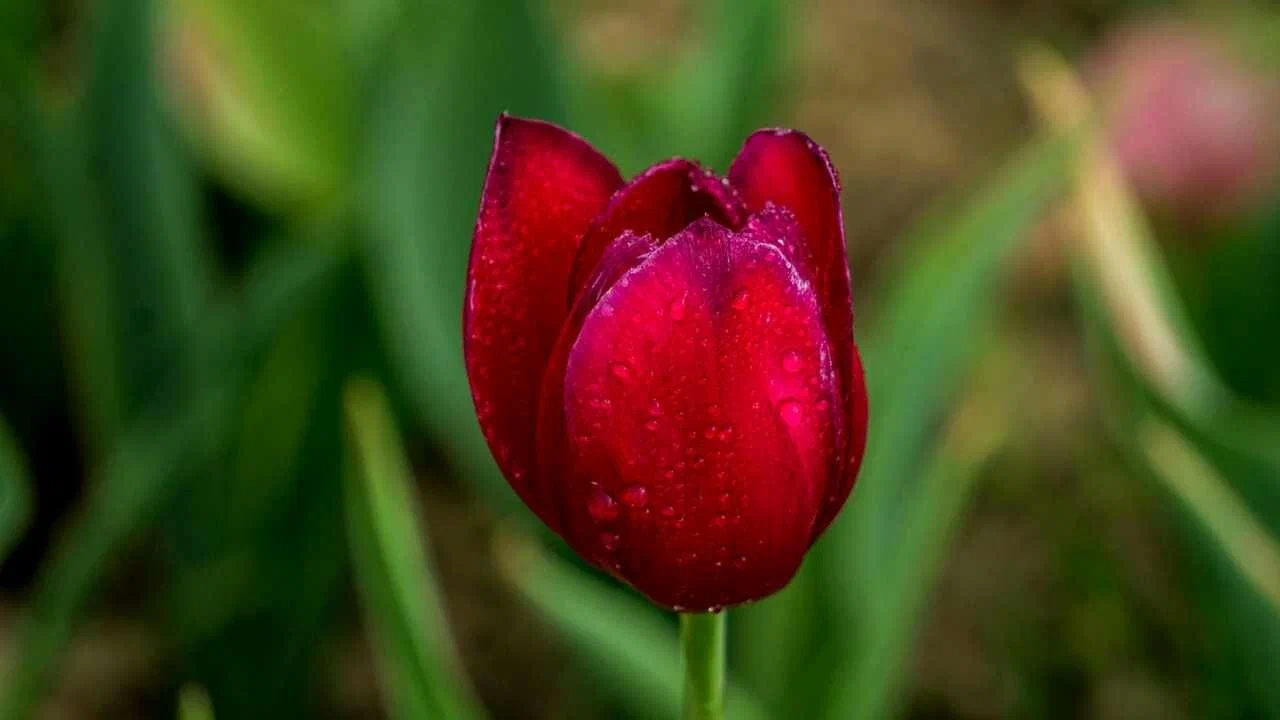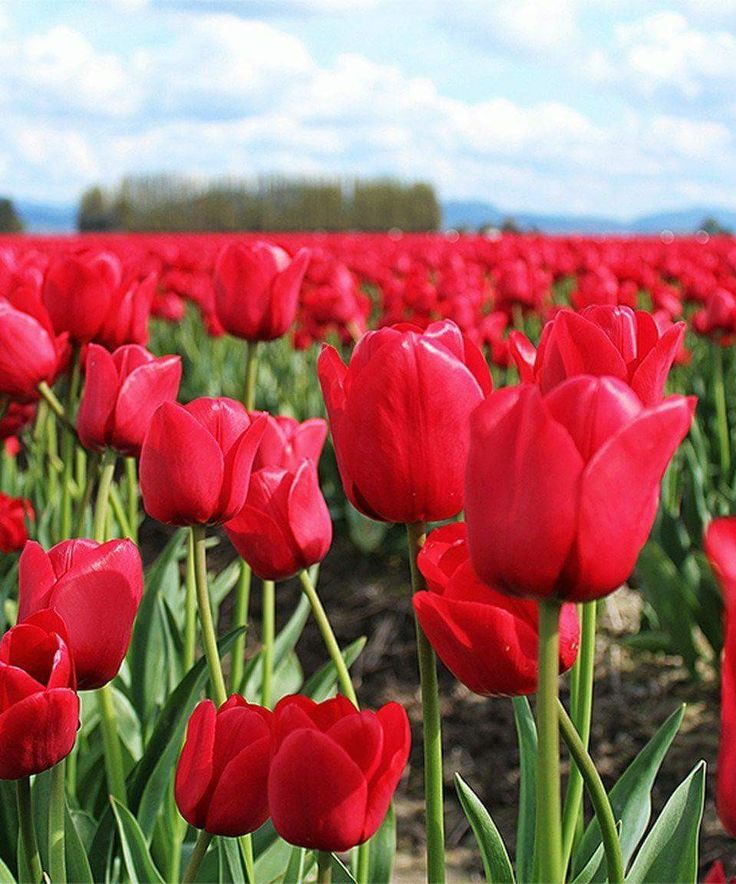Introduction to Red Tulips
The red tulip is one of the most iconic symbols of love and passion in the world of flowers. Often compared to the red rose, the red tulip embodies a unique elegance and charm that makes it stand out. Beyond its radiant hue and perfect symmetry, the red tulip carries a rich tapestry of meanings, stories, and cultural significance.
Historical and Mythological Origins
The Legend of Farhad and Shirin
One of the most enduring legends associated with the red tulip originates from Persia. This romantic and tragic tale tells the story of Farhad, a stonemason deeply in love with a beautiful princess named Shirin. Farhad never had the courage to confess his love. Upon hearing false news of Shirin’s death, he was overcome by sorrow and ended his life. Legend has it that red tulips grew where his blood touched the ground, becoming a symbol of his undying and eternal love for Shirin.
This story deeply entrenched the red tulip in the symbolism of passionate and true love, a meaning that has transcended cultures and centuries.
The Sultan of Persia
Another version of this story focuses on the Sultan of Persia, who used crimson tulips to express his fiery love. The deep red petals of these tulips often have a black center, which many believe represents a charred heart, scorched by the flames of love.
Symbolism and Meaning of the Red Tulip
Love and Romance
Above all, the red tulip signifies true, eternal, and perfect love. It is a flower that communicates feelings of irresistible love, deep passion, and sincere affection. Giving someone red tulips is akin to saying, “I am deeply in love with you” or “You are my one true love.”
Declaration of Love
In Victorian flower language, red tulips conveyed the message of a heartfelt confession. The flower represented the phrase, “Believe me,” and was often used by those hoping to express love and await an honest response.
Irresistible Passion
In various parts of Europe, especially in the Netherlands, the red tulip is seen as a representation of being passionately in love. The imagery of fire and intense emotion is often linked to this flower, further amplifying its romantic symbolism.
Red Tulips in Culture and Tradition
Wedding Symbolism
Red tulips are a popular choice in wedding ceremonies as they represent the deep love shared between the couple. Their elegant shape and bold color add a romantic flair to wedding bouquets, centerpieces, and ceremonial arches.
Feng Shui Beliefs
In Feng Shui, red tulips are considered auspicious. Placing them in the home is believed to attract not just love but also wealth, fame, and recognition. They are often placed in the relationship corner of the home to enhance romantic energies.
Botanical Characteristics of Red Tulips
Color and Shape
Red tulips exhibit a deep, vibrant crimson hue that commands attention. When upright, their petals form a cup shape, while they appear star-shaped when laid flat. This transformation in form adds a layer of complexity and beauty to the flower.
Petal Structure
Each red tulip has six tepals, consisting of three sepals and three petals. Sometimes, the petals are uniformly red, while other times, they may have unique markings or a darker base, often black, enhancing their visual appeal.
Growth After Cutting
An interesting fact about tulips, including red ones, is that they continue to grow even after being cut. In a vase, they can extend by up to an inch or more, a trait that symbolizes life, resilience, and enduring love.
Red Tulips in Numerology
According to numerology, the tulip resonates with the number 6. This number is associated with harmony, love, and nurturing qualities. Individuals connected to the number 6 are considered caring, attractive, and highly lovable, traits reflected in the tulip’s symbolism.
Seasonal Bloom and Botanical Details
Blossom Time
Red tulips typically bloom from April to June, depending on the variety. Early bloomers start showing their colors in April, while late bloomers may blossom as late as June.
Edibility and Toxicity
While tulip bulbs are technically edible and were consumed during times of famine, such as during World War II in the Netherlands, they are also mildly toxic and should be handled with care. The petals are not known for medicinal properties and are primarily ornamental.
Superstitions and Folklore
One whimsical superstition associated with red tulips is that pixies are said to dwell among them. This folklore adds a magical aura to the flower, suggesting it holds mystical qualities beyond its visible beauty.
Red Tulips in Modern Times
In today’s world, red tulips are used in various ways to express affection. Whether in romantic gestures, Valentine’s Day bouquets, or anniversary celebrations, the flower continues to convey heartfelt emotions.
Gift-Giving Occasions
Red tulips are ideal for:
- Anniversaries
- Valentine’s Day
- Weddings
- Romantic proposals
- Birthdays of loved ones
Their versatile symbolism and stunning appearance make them a favored choice for romantic occasions.
Contrast with Other Colors
Red tulips are often compared with tulips of other colors:
- Yellow tulips symbolize cheerful thoughts and friendship.
- White tulips stand for forgiveness and purity.
- Purple tulips indicate royalty and nobility.
- Pink tulips suggest affection and good wishes.
Red tulips, however, stand alone in their intensity and association with deep, passionate love.
Red Tulip in Art and Literature
Artists and poets have often drawn inspiration from the red tulip’s vivid appearance and symbolic meanings. In paintings, red tulips frequently accompany themes of love, longing, and beauty. Writers, particularly in romantic literature, have used them as metaphors for emotional depth and romantic yearning.
Cultivation and Care
Ideal Growing Conditions
Red tulips thrive in temperate climates with well-drained soil. They prefer full sun but can tolerate partial shade. Gardeners are advised to plant the bulbs in the fall, ideally 6 to 8 inches deep, to ensure spring blooming.
Maintenance Tips
- Water moderately but avoid waterlogging.
- Deadhead the flowers once they wilt to redirect energy to the bulb.
- Let the foliage die back naturally to help strengthen the bulb for the next season.
Final Thoughts on the Red Tulip
The red tulip stands as an enduring emblem of love, passion, and devotion. Its history, cultural relevance, and striking appearance have made it a beloved flower worldwide. Whether given as a romantic gift, used in ceremonial décor, or admired in a blooming garden, the red tulip continues to inspire feelings of love and admiration.
As a symbol of eternal love rooted in centuries-old legends and enhanced by its striking aesthetics, the red tulip remains a poetic representation of the human heart’s most profound emotions.
- Sheffield United vs Sunderland LIVE: Championship play-off final result, match stream and latest updates toda - June 5, 2025
- Tulsi Gabbard Net Worth - June 5, 2025
- Explore New Mexico’s THC Infused Beverages - June 5, 2025






